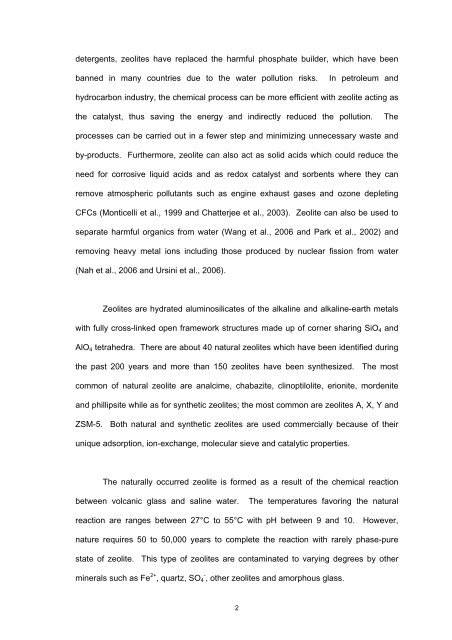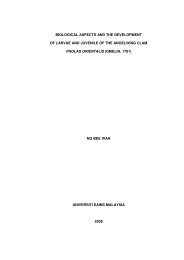SYNTHESIS AND CHARACTERIZATION OF ... - ePrints@USM
SYNTHESIS AND CHARACTERIZATION OF ... - ePrints@USM
SYNTHESIS AND CHARACTERIZATION OF ... - ePrints@USM
You also want an ePaper? Increase the reach of your titles
YUMPU automatically turns print PDFs into web optimized ePapers that Google loves.
detergents, zeolites have replaced the harmful phosphate builder, which have beenbanned in many countries due to the water pollution risks. In petroleum andhydrocarbon industry, the chemical process can be more efficient with zeolite acting asthe catalyst, thus saving the energy and indirectly reduced the pollution. Theprocesses can be carried out in a fewer step and minimizing unnecessary waste andby-products. Furthermore, zeolite can also act as solid acids which could reduce theneed for corrosive liquid acids and as redox catalyst and sorbents where they canremove atmospheric pollutants such as engine exhaust gases and ozone depletingCFCs (Monticelli et al., 1999 and Chatterjee et al., 2003). Zeolite can also be used toseparate harmful organics from water (Wang et al., 2006 and Park et al., 2002) andremoving heavy metal ions including those produced by nuclear fission from water(Nah et al., 2006 and Ursini et al., 2006).Zeolites are hydrated aluminosilicates of the alkaline and alkaline-earth metalswith fully cross-linked open framework structures made up of corner sharing SiO 4 andAlO 4 tetrahedra. There are about 40 natural zeolites which have been identified duringthe past 200 years and more than 150 zeolites have been synthesized. The mostcommon of natural zeolite are analcime, chabazite, clinoptilolite, erionite, mordeniteand phillipsite while as for synthetic zeolites; the most common are zeolites A, X, Y andZSM-5. Both natural and synthetic zeolites are used commercially because of theirunique adsorption, ion-exchange, molecular sieve and catalytic properties.The naturally occurred zeolite is formed as a result of the chemical reactionbetween volcanic glass and saline water. The temperatures favoring the naturalreaction are ranges between 27°C to 55°C with pH between 9 and 10. However,nature requires 50 to 50,000 years to complete the reaction with rarely phase-purestate of zeolite. This type of zeolites are contaminated to varying degrees by otherminerals such as Fe 2+ , quartz, SO - 4 , other zeolites and amorphous glass.2
















